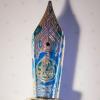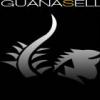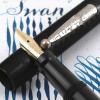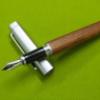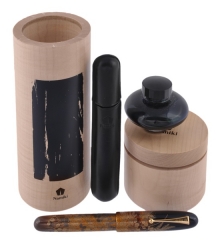Search the Community
Showing results for tags 'namiki emperor'.
-
Namiki Emperor Ink Shut-Off Valve Not Opening
trillfp posted a topic in Fountain & Dip Pens - First Stop
Hello! This is my first time using this forum but I could tell from other threads that this forum has the best advice and experience with stuff like this. I recently bought a Namiki Emperor second-hand and it arrived with the shut-off valve being completely stuck and unable... -
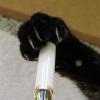
Urushi Studio India Goldfish pen impressions and comparisons
jandrese posted a topic in India & Subcontinent (Asia)
I collect urushi and maki-e pens some of which are from India. Here is my Urushi Studio India Goldfish pen impressions and comparisons. First, I show below photos of the pen by itself then photos alongside Japanese pens with the same theme. 398CB59A-8CF7-4757-86E2-23AC7032FC21 by Ja Ja,...- 11 replies
-
- urushi studio india
- urushi
-
(and 5 more)
Tagged with:
-
Shooting the Sailor Bespoke KOP Chinkin Owl for Dromgoole’s inspired me to pull out my Namiki Emperor Chinkin Dragon and run it through the focus stacked macro ringer. I’d say it availed itself. F8B88398-F81A-4B6A-A5F5-C981F315526F by Ja Ja, on Flickr EE178EB1-23E4-4056-B7BB...
-

Namiki Limited Edition 2021 Coral Emperor first look and writing sample
jandrese posted a topic in Japan - Asia
Here is the mighty No. 50 size Namiki Emperor in the 2021 Limited Edition Coral maki-e. Words cannot express the amazingly superlative incredibleness of this pen. I have some pretty awesome macros I can share in a followup post if anybody is interested. IMG_8256 by Ja Ja, on Flickr- 16 replies
-
- namiki
- namiki limited edition
-
(and 4 more)
Tagged with:
-
Hello, I am looking for a specific pen, a Namiki Nobori Ryu. It was an anniversary pen for Namiki awhile back, and it's a challenge to find. I am willing to be patient, but I don't even know where to start looking... Other than Ebay, can anyone suggest some resources to find a rare Namiki pen?...
- 10 replies
-
- namiki
- namiki emperor
-
(and 2 more)
Tagged with:
-
Hello, I have a question: I just purchased a Namiki emperor and I am having a devil of a time finding a case for it. Any suggestions? Thank you, Maya
-
Considering Taking The Namiki Either Emperor Or Yukari Plunge- Advice Please
Mayacamas posted a topic in Fountain & Dip Pens - First Stop
Hello, I have been lurking for a few years, and have a small collection of German and Italian pens that I use daily-- Im a writer. I have become increasingly convinced that I need a Namiki pen and have looked at both the Emperor and the Yukari Royale line. May I get advice on: 1. Useablity-... -
Namiki Emperor Vermillion Or Montblanc 149 Silver Rings Celluloid
mulrich posted a topic in Fountain & Dip Pens - First Stop
Any thoughts or opinions on the Namiki Emperor Vermillion or Montblanc 149 silver rings celluloid? These are obviously stupidly expensive pens so I can be happy if I never buy either but I came across decent deals on each and am considering getting one of them. They are very different pens (except f... -
I'm relatively new to collecting fountain pens, but having now rotated through 'collecting' other things over the years (and I, like most people, actually hoard rather than collect, in the true sense of the word), I know how things ultimately play out. Whether it be camera equipment, watches, even...
- 66 replies
-
- namiki emperor
- pilot
-
(and 1 more)
Tagged with:
-
Hello and I trust you all had a Merry Christmas. My husband pulled a surprise on me today. After the last of our house guests left he gave me my Christmas present, a 2017 Namiki Emperor Dragon. He made it clear the gift was for Christmas and our 50th anniversary. I am still a bit shell-shocked. T...
-
We are delighted to announce a new Namiki Emperor will launch this November 2016. The dragon, is one of Asia's most important mythical creatures and it will be the one to adorn this new version of Namiki Emperor fountain pen. Endowed with supernatural powers, this creature is usually linked to...
-
Three Emperor pens have been stolen from Aesthetic Bay in Singapore: http://onfountainpens.com/2015/10/stolen-namiki-pens-please-help/#comment-6117
-
I had both the pens inked on my desk and decided to take some pictures, Both pens are designed to be ED filled, from the same company, but what a wide gulf separates them, it is mind boggling to think of what Pilot have achieved as a pen company. For those who might be unfamiliar, the bigger pen i...
- 12 replies
-
- namiki emperor
- pilot nsf
-
(and 1 more)
Tagged with:
-
I feel the Namiki Emperor is the ultimate eyedropper pen. Huge, so huge that other big pens start looking tiny in front of it. Positively huge nib, yet the pen is very comfortable to use. Some pics with a Vermillion Dani Trio Mikado and a black Sho Genkai. The maki-e pattern on this Emperor is calle...


